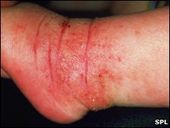
© SPLEczema causes red itchy patches on the skin
There was a 42% rise in diagnosis of the condition between 2001 and 2005, by which time it was estimated to effect 5.7m adults and children.
One potential explanation for the rise is increased frequency of bathing and use of soap and detergents.
A paper in the
Journal of the Royal Society of Medicine says eczema is thought to be a trigger for other allergic conditions.
GP records of over 9m patients were used by researchers to assess how many people have the inflammatory skin disorder.
It showed that by 2005, one in nine of the population had, at some point, been affected by eczema.
The highest rate was in boys aged between five and nine.
Prescriptions increased by 57% over the five-year study period and in 2005, GPs issued 13.7m scripts.
Study leader Professor Aziz Sheikh, chair of the allergy and respiratory research group at the University of Edinburgh, said he expected to see a rise but it was fairly marked given the short time period.
